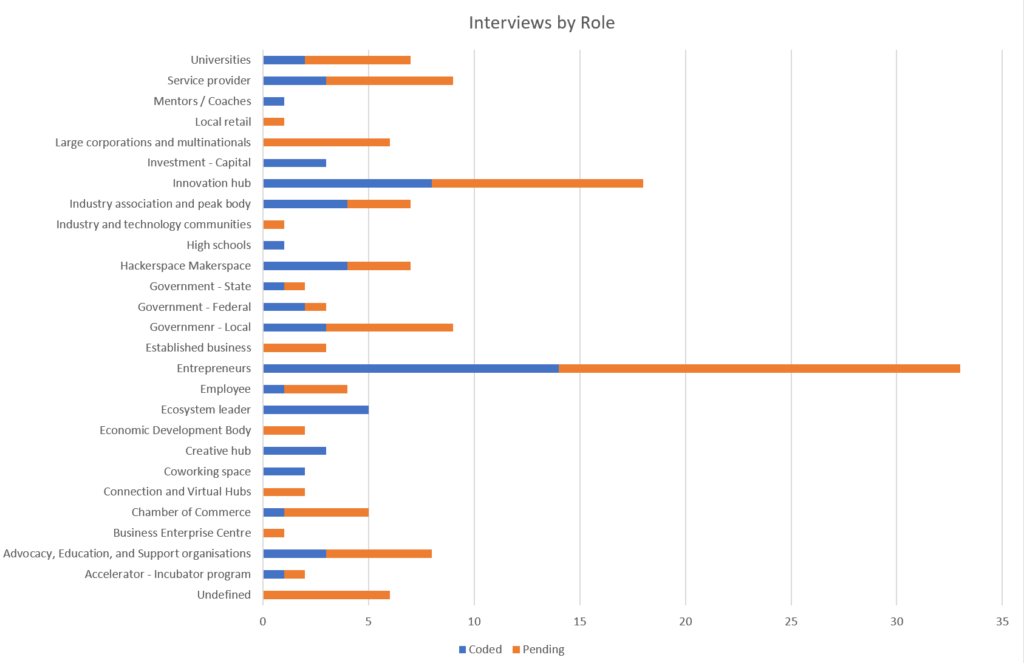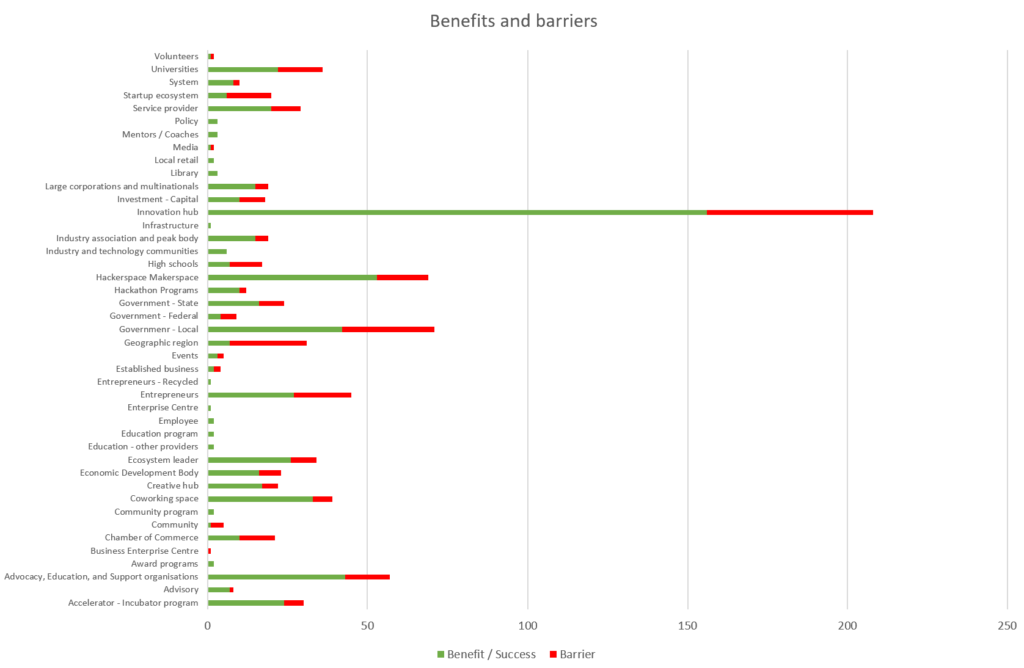Network analysis of an entrepreneur ecosystem – PhD in progress
As the data from interviews begins to form interesting pictures, I share insights into the process and perspectives of a personal and collective journey.
An update on the PhD
A PhD begins with a question and some informed guesses on potential answers. You look at that question for a few years until you have pulled it – and at times yourself – apart and examined it from as many perspectives as possible.
Three years ago I asked a question about the role of innovation hubs in regional communities specifically looking at community resilience. For the purpose of the study, innovation hubs are loosely defined as a physical or virtual hub focused on supporting entrepreneurs in a physical region.
The first year was spent living the research, managing an innovation hub in a regional setting. I also traveled overseas to understand whether I was asking the right question. The next year I explored possible answers through the development of measurement models to test in regions. I then hit the road to add the voices of over 180 interviews across Queensland. My original plan for a national tour is still in the works, but pending the completion of the PhD.
The past six months have been a tension between a desire to practically apply lessons from the research, gather more data, and a need to complete the thesis and publish results. Academic pressures and deadlines are resolving this tension as I complete the data analysis and thesis writing.
Coding and theory
I have come to a healthy appreciation for what it mean to “process interview data”. My process involved first transcribing interview content using an automated AI service (Temi worked well to get to around 95% accuracy, even with Aussie accents) followed by manual review to clean up of of video and audio content using Nvivo to manage files.
Each transcription is then “coded”. Coding involves looking at each comment in each interview:
- First, I code who is doing what to who. This is defined as the role and actor that is doing the acting and the role and actor being acted upon. For example, local government (role) of Rockhampton Regional Council (actor) acts on the innovation hub (role) of Rockhampton Smart Hub (actor);
- Second, I code the nature of the action being described. This is grouped in one of five ways: 1) How they define themselves or others ; 2) How they describe a benefit or past success about the actor or relationship; 3) How they highlight a barrier to the actor or relationship; 4) How they describe a vision of the best possible future related to the actor; or 5) How they outline a strategy that will achieve the vision; and
- Third, the function being performed as an open description and of the function being performed, for example talent, access to capital, culture, personal support, access to external markets, etc.
The end goal will paint a picture of how types of actors view other types of actors and a collective vision and strategy for the ecosystem. This picture is formed with theories that define a view of the world. Continuing the art metaphor, it is like ensuring there is a solid canvas on which to paint.
The three theories used to define the canvas are:
- Actor Network Theory (ACT): A challenge with ecosystem models is that they can put people into a box, missing emerging roles and functions in a rapidly changing innovation system. Actor Network Theory treats everything as an “actor” that defines his/her/its role within the context of the entrepreneur ecosystem). I start with asking “Who are you and what do you do?” and hear and observe how they describe themselves and see what groupings may occur. This also includes capturing non-human actors such as people acting against a geographic region or using a piece of infrastructure or technology asset.
- Critical realism: Each person’s narrative is reality and true for them. We assume truth and unconditional positive regard, and consider why two truths differ rather than determining why one view is right or another view is wrong. We then critically review each truth against the relative truths of other interviews, previous academic literature, case studies, theories, organisational operational data, and data from economic and regional statistics and metrics.
- Appreciative Inquiry: Finally, the interviews are conducted using a strengths-based framework called Appreciative Inquiry. First, the strengths and past successes are identified. Second, the best possible future or vision is captured from a perspective of it already having occurred. Third, we discuss strategies that happened to make the vision reality. Finally, we identify the individual’s role in that strategy. Combined, the responses create a collective view of the entrepreneur ecosystem.
The network
Over 180 interviews were conducted, and over 150 have been transcribed. Interviews were selected based on a sample of roles as well as opportunities and introductions while I was in a region. The quantity may seem like a high number until it is divided into the number of roles across different regions and then multiple positions in a given organisation. The aim is to get a diverse range of perspectives and see how those differ by role and region.
There are currently identified 55 roles filled by 322 actors. The actor defines their role by describing how they see themselves working with others towards supporting entrepreneurs. These are fluid and an actor can fulfill multiple roles, but a primary role is defined.

Interviews are captured against thirteen regions. Region boundaries can vary. For example, some actors identify with “Far North Queensland” while others with Cairnes or Atherton. There is always a sense of place that becomes an actor in itself interacting with other actors. The culture, history, and sense of belonging play an important role.
Over 1,300 individual codes or observations have been pulled from the interviews so far. These will be grouped in the coming weeks to further develop themes. Each participant was asked about what is working well and challenges in general terms. Below is an overview of instances of benefits and barriers against each actor. The question structure leaned towards positive. Asking about the best possible future also identifies areas that can be improved. Barriers were simply areas that could be improved rather than being positioned as a negative.

The resulting network map produced using Gephi highlights the complexity of support for entrepreneurs. There is high interconnectivity and key actors span multiple regions. An entrepreneur getting into dense areas of the system can accelerate progress. Part of the work and the focus on regional areas is to identify how social and digital systems might address challenges resulting from low density inherent to geographic distance from metro areas.
The size of the node is based on number of observations. Even without detailed content analysis and acknowledging the bias from the focus of the interview, we can make some observations from where people took the conversations.
- Innovation hubs act as an important nexus and boundary spanner in a region.
- Entrepreneurs are always the central focus.
- The ecosystem leader is critical to building capability.
- The startup ecosystem and geographic region play an important role as a connection to place.
- Local governments are important in non-metro regions, and other major actors of universities and large corporates are critical for functions such as legitimacy and market access.
- There is a unique role for advocacy and support entities, which are emerging as a key function in the ecosystem.

Work in progress
This work has taken me longer than I anticipated (but as long as others warned me about). However, my excitement about outcomes increases each week. What is emerging is a framework that we can view from multiple perspectives:
- How does diversity impact entrepreneur support?
- What are effective strategies for local government?
- How do universities connect to regional innovation programs?
- Where are the crossovers and gaps in entrepreneur support?
- What are the most important factors when starting an entrepreneur ecosystem?
Perspectives on these questions are emerging from the data. I look forward to releasing more in coming weeks as we move towards completion.
Feedback and conversation is always welcome. Thank you for joining me on the journey.
